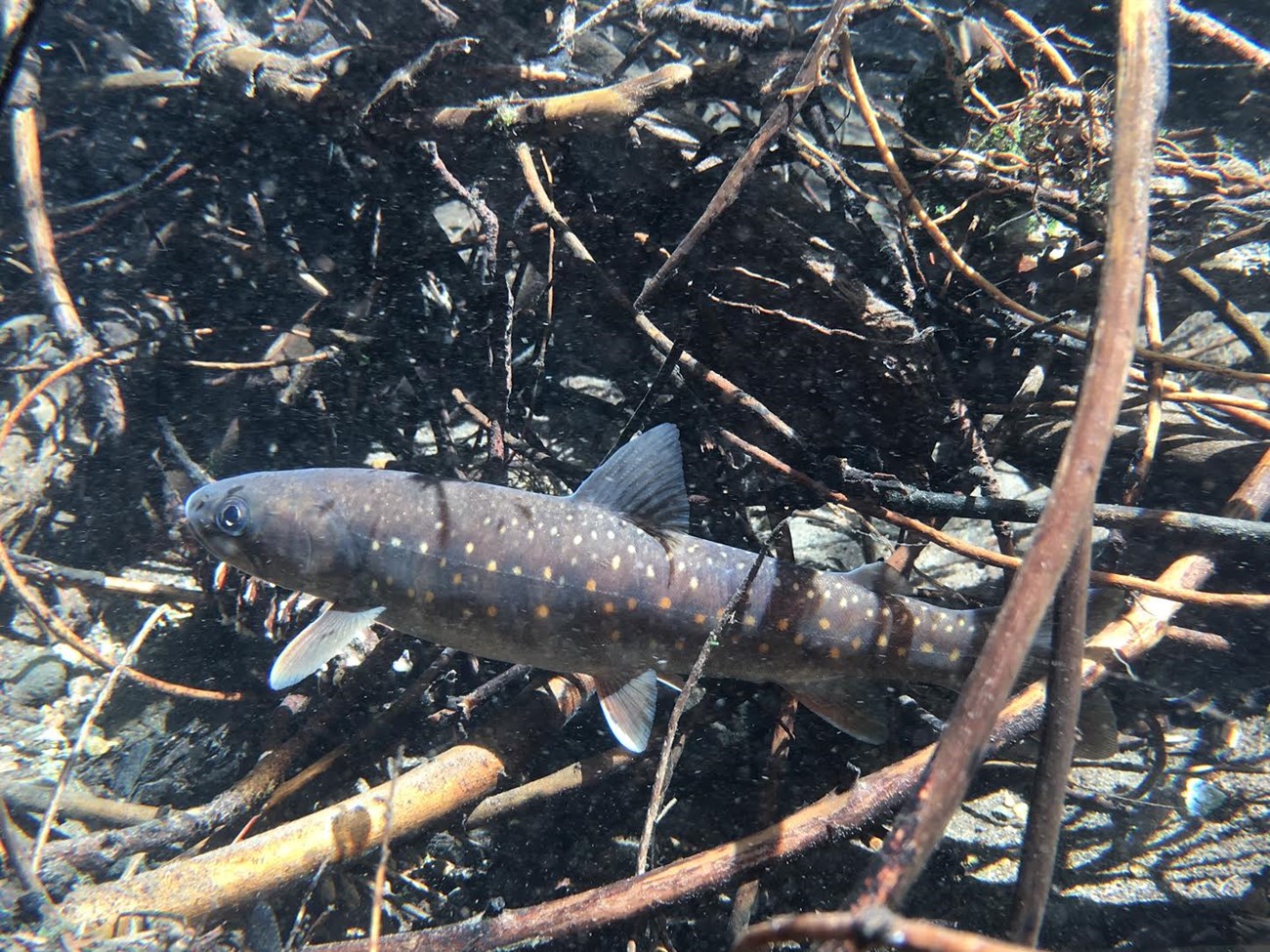Last updated: July 31, 2025
Article
Bull Trout

NPS/J. Lemanski
General Description
When is a trout not a trout? Bull trout (Salvelinus confluentus) are a type of char. Both “trout” and “char” are members of the family Salmonidae. Though bull trout were on the verge of extinction only decades ago, recovery efforts are helping to bring them back, including in one creek at Crater Lake National Park.
Often confused with Dolly Varden (Salvelinus malma), their closely related char cousins, bull trout are generally dull brown or dark olive with round, light orange, yellow, or crimson spots on their sides fading to a white belly. Based on genetics, these two species were differentiated in the late 1970s and can be distinguished by comparing eye location, gill structure (rakers), and teeth, among other traits. Bull trout in Crater Lake National Park grow to 37 cm (15 in) and nearly 0.5 kg (1 lb), smaller than their migratory brethren in other parts of the species' range.
Habitat and Range
Bull trout live in montane streams throughout their range in the Upper Yukon River, British Columbia, Washington, Idaho, Oregon, Northern Nevada, and formerly the McCloud River drainage in Northern California. Like all salmonids, they require “the four Cs” to thrive: “cold” and “clean” waters in “complex” streams, “connected” to a larger watershed. They thrive in cool, deep pools within suitable stream habitats. Complex streams feature varied depths and water velocities, streambed characteristics like gravel and sand, and sometimes large wood or overhanging banks for shelter and rest. Tributaries flowing freely (connected) into larger river systems allow growing fish to migrate and find more resources.
At Crater Lake National Park, bull trout live in the clean, fast-moving waters of Sun Creek on the south slopes of the park. They have been isolated for over 100 years from the rest of the Upper Klamath River population due to the creek’s diversion for agricultural irrigation. In 2017, Sun Creek was reconnected downstream to the Wood River through a significant collaborative effort between the National Park Service, US Fish and Wildlife Service, Oregon Department of Fish and Wildlife, private landowners, and nonprofit organizations. (See Oregon Field Guide link below.) After connectivity was restored, some individuals have begun to migrate, increasing behavioral diversity within the population.
Diet and Reproduction
Young bull trout feed on terrestrial and aquatic insects. They prey on small fish as adults. They spawn in clean gravel and cobble substrate in the fall when the water temperature drops below 9 °C (48 °F). Bull trout leave their fertilized eggs in unguarded nests called “redds.” They can spawn in multiple years (iteroparous), unlike many species of anadromous Pacific salmon that spawn only once (semelparous). Eggs require a long, 4–5 month incubation period before hatching in late winter or early spring. Bull trout usually reach sexual maturity in 4 to 7 years, living frequently for 10 and even up to 20 years!

NPS/D. Hering
Conservation
The US Fish and Wildlife Service listed upper Klamath River watershed bull trout as threatened in 1998 under the Endangered Species Act. A year later, all other bull trout in the United States were listed. In Crater Lake National Park, conservation and recovery efforts preceded the listings by a decade because of the National Park Service’s mandate to preserve and protect native species within its boundaries. Brook trout (Salvelinus fontinalis), a nonnative species introduced decades ago for sportfishing across the West, were identified as the main impediment to bull trout recovery. Brook trout interbreed with and outcompete native bull trout in the same habitat. The offspring of bull trout and brook trout unions are mostly sterile. Starting in the early 1990s, intensive and consistent brook trout removal by park scientists in Sun Creek has brought bull trout back from the verge of local extinction. Bull trout numbers have recovered in Sun Creek from less than 150 in the late 1980s to over 4,000 in 2025—enough to attempt reintroduction of Sun Creek bull trout into Annie Creek, another historical bull trout home within the park’s boundaries.
Where to See
In the Klamath Network, bull trout are found only in Crater Lake National Park. If you go, please respect that Sun Creek is closed to angling in the park to help these fish recover.
Learn More

Prepared by Scotty Stalp, Southern Oregon University intern
NPS Klamath Inventory & Monitoring Network
Southern Oregon University
1250 Siskiyou Blvd
Ashland, OR 97520
Featured Creature Edition: October 2025
